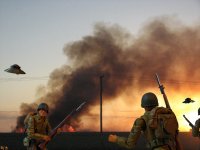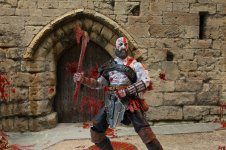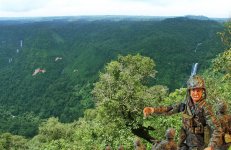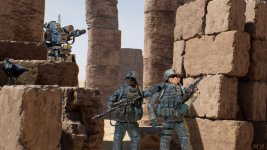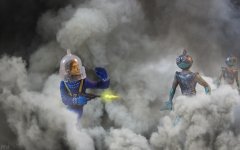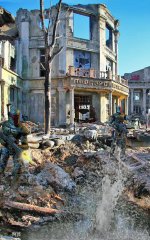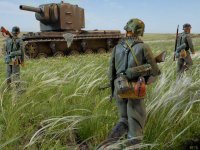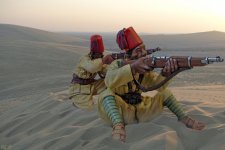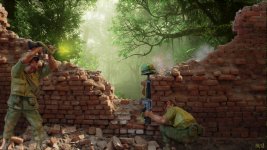You are using an out of date browser. It may not display this or other websites correctly.
You should upgrade or use an alternative browser.
You should upgrade or use an alternative browser.
Some of my work (1 Viewer)
- Thread starter arditi
- Start date
Nazi Saucers from Hell! The US heartland is invaded by the Nazis' in late 1948! ...wink.
View attachment 228109
Aaaa, yes, from the nazi base on the moon!
arditi
Specialist
- Joined
- Dec 12, 2013
- Messages
- 284
Brilliant Russ, Your best so far, though I was looking to see that there weren't any Aliens etc lurking about as well as the Japs !
Well done mate !:salute::
Steve
Haha! I forgot the Aliens working with the Japanese! You are very kind Sir! Thank you.
arditi
Specialist
- Joined
- Dec 12, 2013
- Messages
- 284
arditi
Specialist
- Joined
- Dec 12, 2013
- Messages
- 284
Photograph by our own Martin Cordova. I have added German figures to, hopefully, make a moment in history.
Older wehrmacht veterans patrol the coast of Southern France in early August. On the 15th they will have to contend with fury. The troops were positioned thinly along the French coast, with an average of 90 km (56 mi) per division. Generally, the troops of the German divisions were only second and third rate. This meant that over the course of the war, the divisions were thinned out and soldiers were replaced with wounded old veterans as well as Volksdeutsche from Poland and Czechoslovakia. Numerous units were also replaced by Ostlegionen and Ostbataillone. These units were volunteers from Eastern Europe, mainly the Soviet Union, and had a generally low fighting morale. The equipment of those troops was in poor shape, consisting of old weapons from various nations, with French, Polish, Soviet, Italian, and Czech guns, artillery, and mortars. Four of the German divisions were designated as "static", which meant that they were stripped of all of their mobile capabilities and unable to move from their position. The only potent unit inside Army Group G was the 11th Panzer Division, which was commanded by Wend von Wietersheim. Wikipedia
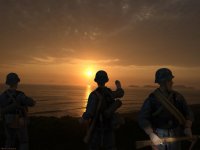
Older wehrmacht veterans patrol the coast of Southern France in early August. On the 15th they will have to contend with fury. The troops were positioned thinly along the French coast, with an average of 90 km (56 mi) per division. Generally, the troops of the German divisions were only second and third rate. This meant that over the course of the war, the divisions were thinned out and soldiers were replaced with wounded old veterans as well as Volksdeutsche from Poland and Czechoslovakia. Numerous units were also replaced by Ostlegionen and Ostbataillone. These units were volunteers from Eastern Europe, mainly the Soviet Union, and had a generally low fighting morale. The equipment of those troops was in poor shape, consisting of old weapons from various nations, with French, Polish, Soviet, Italian, and Czech guns, artillery, and mortars. Four of the German divisions were designated as "static", which meant that they were stripped of all of their mobile capabilities and unable to move from their position. The only potent unit inside Army Group G was the 11th Panzer Division, which was commanded by Wend von Wietersheim. Wikipedia

arditi
Specialist
- Joined
- Dec 12, 2013
- Messages
- 284
A little bit of liquid courage before the push on the Stalingrad grain silo.
In Stalingrad the fighting was as intense as ever as the Germans threw everything they had into the battle in a ‘last’ attempt to capture the whole city. Yet they faced some of of the most determined resistance they had ever encountered.
The Russians clung on to a strip of land on the west back of the Volga. All reinforcements and all munitions and supplies had to cross the wide Volga, which was continuously under fire from the German guns. Men who crossed were immediately flung into the battle. Life expectancy was little more than a day for Soviet infantrymen who crossed at this time.
The Germans were being made to fight for every building. Small groups of men would creep into houses after dark with sufficient ammunition to keep them going for a few days, fortify it as best they could, and then fight it out from their own personal ‘Alamo’, selling their lives as dearly as possible.
Similar battles took place in the industrial buildings. The Grain Elevator was built like a fortress with solid concrete walls. This became the site of a famous battle as a small group of men held out against everything the Germans could throw at them, including tanks and Stuka bombing. They carried on even as the grain stores caught fire. Eighteen sailors from the 92nd Independent Rifle Brigade commanded by Andrei Khozyainov fought their way through to join them on the 17th:
The guardsmen were very pleased to see us, and immediately began cracking army jokes and making funny remarks. We had two Maxim guns, one light machinegun, two anti-tank rifles, three tommyguns and a radio set.
At dawn on the 18th a German tank carrying a white flag approached from the south. ‘What’s going on?’ we thought. Two men showed themselves from inside the tank, a Nazi officer and an interpreter.
Through the interpreter the officer tried to persuade us to surrender to the ‘glorious’ German army, as defence was useless and there was no point in our sitting it out any longer. ‘Get out of the elevator now,’ insisted the German officer. ‘If not we will show you no mercy. In one hour’s time we will bomb you all flat.’
‘What a cheek,’ we thought, and gave the Nazi lieutenant a curt reply: Tell all your fascists they can go to hell in an open boat! You two ‘voices of the people’ can go back to your lines, but only on foot. The German tank tried to back away, but a volley from our two anti-tank rifles stopped it.
Soon after that enemy tanks and infantry about ten times our strength attacked from south and west. After the first attack was beaten back a second began, then a third, and all the while a reconnaissance plane circled over us. It corrected the fire and reported our position. Ten attacks were beaten off just on September 18th.
We were very careful with our ammunition, as it was a long way to bring up more, and a difficult trip. In the elevator the grain was on fire, and the water in the machineguns evaporated. The wounded kept asking for something to drink, but there was no water nearby. This was how we defended our position, day and night. Heat, thirst, smoke – everybody’s lips were cracked.
Andrei Khozyainov’s account appears in Jonathan Bastable (ed): Voices From Stalingrad
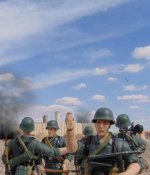
In Stalingrad the fighting was as intense as ever as the Germans threw everything they had into the battle in a ‘last’ attempt to capture the whole city. Yet they faced some of of the most determined resistance they had ever encountered.
The Russians clung on to a strip of land on the west back of the Volga. All reinforcements and all munitions and supplies had to cross the wide Volga, which was continuously under fire from the German guns. Men who crossed were immediately flung into the battle. Life expectancy was little more than a day for Soviet infantrymen who crossed at this time.
The Germans were being made to fight for every building. Small groups of men would creep into houses after dark with sufficient ammunition to keep them going for a few days, fortify it as best they could, and then fight it out from their own personal ‘Alamo’, selling their lives as dearly as possible.
Similar battles took place in the industrial buildings. The Grain Elevator was built like a fortress with solid concrete walls. This became the site of a famous battle as a small group of men held out against everything the Germans could throw at them, including tanks and Stuka bombing. They carried on even as the grain stores caught fire. Eighteen sailors from the 92nd Independent Rifle Brigade commanded by Andrei Khozyainov fought their way through to join them on the 17th:
The guardsmen were very pleased to see us, and immediately began cracking army jokes and making funny remarks. We had two Maxim guns, one light machinegun, two anti-tank rifles, three tommyguns and a radio set.
At dawn on the 18th a German tank carrying a white flag approached from the south. ‘What’s going on?’ we thought. Two men showed themselves from inside the tank, a Nazi officer and an interpreter.
Through the interpreter the officer tried to persuade us to surrender to the ‘glorious’ German army, as defence was useless and there was no point in our sitting it out any longer. ‘Get out of the elevator now,’ insisted the German officer. ‘If not we will show you no mercy. In one hour’s time we will bomb you all flat.’
‘What a cheek,’ we thought, and gave the Nazi lieutenant a curt reply: Tell all your fascists they can go to hell in an open boat! You two ‘voices of the people’ can go back to your lines, but only on foot. The German tank tried to back away, but a volley from our two anti-tank rifles stopped it.
Soon after that enemy tanks and infantry about ten times our strength attacked from south and west. After the first attack was beaten back a second began, then a third, and all the while a reconnaissance plane circled over us. It corrected the fire and reported our position. Ten attacks were beaten off just on September 18th.
We were very careful with our ammunition, as it was a long way to bring up more, and a difficult trip. In the elevator the grain was on fire, and the water in the machineguns evaporated. The wounded kept asking for something to drink, but there was no water nearby. This was how we defended our position, day and night. Heat, thirst, smoke – everybody’s lips were cracked.
Andrei Khozyainov’s account appears in Jonathan Bastable (ed): Voices From Stalingrad

arditi
Specialist
- Joined
- Dec 12, 2013
- Messages
- 284
Enemy Mech hunting with a WWII German "hafthohlladung" magnetic grenade/mine. WWII has been going on for 72 years now. Old is mixed with the new. New technologies have developed from the wartime research and development. In addition, pure grit and the old is still effective when in need. This member of the 1st Texas Colonial Marine battalion is aiding his comrades by knocking out the Italo-German battle-mechs that have laid waste to parts of Texas. This key encounter for continued Texas Independence shows Medal of Honor recipient Corporal Jesse Hudson preparing to move towards another Axis mech and attach his "hafthohlladung" of WWII vintage. Another mech has been dispatched by his compadre, Sergeant Russ Arendell, and died in the successful attempt. Corporal Hudson went on to destroy 8 of the effective and deadly mechs that day, saving his team's position and denying the recce-foray into Lubbock, Texas proper that day. This picture illustrates the Corporal's "David and Goliath" moment.


Horus
Major General
- Joined
- Nov 20, 2015
- Messages
- 14,563
Italian Askari act as skirmishers, Libya 1940-41. King and Country and photoshop.
View attachment 233219
Russ, as usual good work with the photo shopping.
Steve
Users who are viewing this thread
Total: 2 (members: 0, guests: 2)


